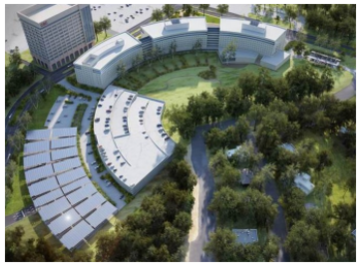
New Carrollton Federal Building, Lanham, MD
60% energy savings. This is how much the deep energy retrofit project at the New Carrollton Federal Building successfully saved. Saving energy is typically cheaper than generating it, and deep energy retrofits that take advantage of triggers such as planned renovations or end of life for major building equipment can cut energy costs by 50% or more.
A deep energy retrofit achieves at least 30% in energy savings and non-energy benefits (such as higher occupant satisfaction rates) versus only 10-20% savings in standard retrofits. Standard retrofits focus on “low hanging fruit” (short payback Energy Conservation Measures) — generally, simple and often discrete upgrades to energy or water-using systems. In contrast, deep energy retrofits use a comprehensive building analysis to identify and integrate (or bundle) systems requiring updates in order to multiply opportunities for savings.
The success of this strategy can be seen at the New Carrollton Federal Building, where lighting and heating updates were combined to reduce energy costs. This resulted in 60% energy reduction and 56% water reduction, particularly impressive given the relatively efficient operation of the original building. The project hinged upon a 40% downsizing of the existing chiller system, made possible through integrative, whole-system design—and bolstered by local utility incentives.
The bottom line? With an average of 34% in savings over baseline energy usage, as demonstrated through GSA's National Deep Energy Retrofit Program, deep energy retrofits allow the government to double or triple its savings with little or no upfront cost.
Kinga Porst Hydras serves as an energy and water efficiency expert in OFHPB with particular focus on the usage of ESPCs in the Federal Government and achieving deep energy retrofits in existing buildings.
Sharon Conger is the Project Executive for the National Deep Energy Retrofit Program in GSA’s Central Office Facilities Management and Special Programs Division. |